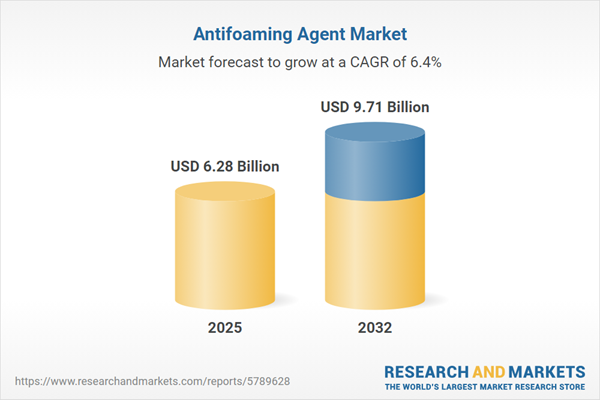Speak directly to the analyst to clarify any post sales queries you may have.
Senior leaders navigating evolving industrial landscapes are approaching the antifoaming agent market as a crucial lever for aligning operations with emerging regulatory frameworks, sustainability drivers, and shifting production priorities. Strategic adaptation within this sector is increasingly necessary for organizations positioning themselves to lead through change.
Market Snapshot: Antifoaming Agent Market Overview
The global antifoaming agent market displays resilient year-over-year growth and robust adoption across manufacturing and processing industries. Currently valued at USD 5.90 billion in 2024, the market is projected to rise to USD 6.28 billion by 2025, following a compound annual growth rate (CAGR) of 6.42%. By 2032, estimates place the market at USD 9.71 billion. As companies incorporate advanced antifoaming technologies, they secure improved compliance with rigorous regulatory standards and realize measurable gains in process efficiency. Increasing integration of these agents helps companies reimagine procurement and operational models, even when facing the complexities of legacy systems and digital transformation pressures.
Scope & Segmentation: Antifoaming Agent Market
- Product Types: Non-silicone antifoaming agents include fatty acid-based, mineral oil-based, phospholipid-based, and polymer-based solutions, each selected to meet sector-specific safety and toxicity requirements. Silicone-based options, particularly those utilizing polydimethylsiloxane (PDMS), deliver high reliability and withstand challenging operational environments.
- Applications: Antifoaming agents are integrated into core sectors such as food and beverage, biotechnology, brewing, dairy, sugar refining, vegetable oil production, pharmaceuticals, paints and coatings, pulp and paper, oil and gas, and water treatment, where process interruptions and product integrity are critical concerns.
- Forms: Available in emulsion, liquid, and powder forms, these agents enable flexible deployment strategies for both batch and continuous processes within automated or manual systems.
- Distribution Channels: Direct manufacturer agreements, established third-party distributors, and emerging digital procurement solutions together enhance transparency and cost flexibility across the supply chain.
- Geographic Regions: Adoption trends and market behavior differ across the Americas, Europe, Middle East and Africa, and Asia-Pacific, with local regulation, investment in capital equipment, and access to new technologies shaping purchasing decisions.
- Leading Industry Players: Notable companies influencing technology and market competition include Dow Inc., Evonik Industries AG, BASF SE, Wacker Chemie AG, Croda International plc, Clariant AG, Nouryon Holding B.V., and Solvay S.A., whose innovations underpin ongoing sector growth.
Key Takeaways and Strategic Insights
- Silicone-based antifoaming agents provide operational reliability, particularly in manufacturing environments where complex machinery or frequent process adjustments are present.
- Industries with rigorous purity and safety standards, such as pharmaceuticals and food production, continue to rely on non-silicone antifoaming agents, ensuring compliance in sensitive process streams.
- Sustainability considerations are increasingly central to procurement strategies, driving organizations to favor partners and solutions that help minimize environmental risk while supporting long-term business value.
- Continuous advancements in polydimethylsiloxane and emulsifier technologies allow users to maintain high performance in processes characterized by elevated shear forces or process volatility, minimizing quality risks.
- Asia-Pacific emerges as a region with strong demand expansion, propelled by rapid industrial investment and water infrastructure upgrades, which create viable entry opportunities for current and future suppliers.
- Supply chain resilience is reinforced by diversifying suppliers, embracing localized production, and targeting logistics innovation to reduce operational exposure to unforeseen disruptions.
Tariff Impact and Adaptive Sourcing Strategies
Recent tariff changes in the United States continue to shape sourcing and manufacturing dynamics, with many companies now diversifying their supplier networks and increasing regional production capacity. This shift emphasizes the importance of multi-year contracts and collaborative value chain relationships for greater stability and predictability as regulations evolve.
Methodology & Data Sources
The findings in this report derive from in-depth interviews with engineers, procurement specialists, and regulatory contacts, supported by technical literature surveys, patent reviews, sector-wide benchmarking, and peer analysis. This approach enables the delivery of reliable, actionable market data for informed strategic planning.
Why This Antifoaming Agent Market Report Matters
- Enables senior executives to refine sourcing, operations, and compliance strategies to meet shifting regulatory and industry standards.
- Supports procurement and process leaders in anticipating risk, enhancing efficiencies, and maintaining more robust supply networks.
- Equips leadership teams with knowledge to align investment priorities and sustainability objectives with forward-looking market trends.
Conclusion
This analysis offers essential data and practical strategies for leadership teams committed to steering effective responses and operational continuity as the antifoaming agent market evolves.
Additional Product Information:
- Purchase of this report includes 1 year online access with quarterly updates.
- This report can be updated on request. Please contact our Customer Experience team using the Ask a Question widget on our website.
Table of Contents
3. Executive Summary
4. Market Overview
7. Cumulative Impact of Artificial Intelligence 2025
Companies Mentioned
The companies profiled in this Antifoaming Agent market report include:- Dow Inc.
- Evonik Industries AG
- BASF SE
- Wacker Chemie AG
- Croda International PLC
- Clariant AG
- Nouryon Holding B.V.
- Solvay S.A.
Table Information
| Report Attribute | Details |
|---|---|
| No. of Pages | 188 |
| Published | November 2025 |
| Forecast Period | 2025 - 2032 |
| Estimated Market Value ( USD | $ 6.28 Billion |
| Forecasted Market Value ( USD | $ 9.71 Billion |
| Compound Annual Growth Rate | 6.4% |
| Regions Covered | Global |
| No. of Companies Mentioned | 9 |









